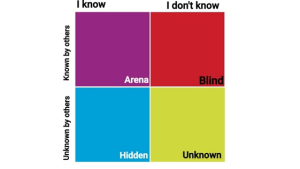17 Chapter 17 – Feedback
Feedback, Curiosity, and Mindfulness
The middle stage of a role—after onboarding but before any potential transition—is a prime time for professional growth, skill enhancement, and reputation building. This phase is when you deepen your understanding of your role, clarify your strengths, and develop relationships that enhance your career. Three interconnected practices can help you grow during this stage: seeking and responding to feedback, nurturing professional curiosity, and cultivating mindfulness.
Seeking Feedback
Feedback is a powerful tool for self-awareness and growth, yet it’s often met with apprehension. Research shows that regular, constructive feedback increases learning, adaptability, and even career satisfaction (Anseel et al., 2013). However, professional growth requires more than just receiving feedback; it depends on actively seeking feedback, interpreting it constructively, and integrating it into your development.
The key to professional growth lies in actively seeking feedback, interpreting it constructively, and integrating it into your development.
The Johari Window Model
 The Johari Window model, developed by psychologists Joseph Luft and Harrington Ingham in 1955, helps us understand why feedback is valuable. This psychological tool categorizes self-awareness into four areas:
The Johari Window model, developed by psychologists Joseph Luft and Harrington Ingham in 1955, helps us understand why feedback is valuable. This psychological tool categorizes self-awareness into four areas:
- Open Area (Arena): Information known to both you and others, including your behaviors, skills, and public knowledge. Expanding this area through effective communication and feedback leads to better understanding and collaboration.
- Blind Area: Information others know about you but you’re unaware of. Feedback reveals these “blind spots,” helping you identify both strengths and areas you were unaware of.
- Hidden Area: Information you know but don’t share with others, like private thoughts or insecurities. Sharing relevant aspects of this area can build trust and strengthen relationships. At the same time, it can be appropriate to keep some things just to yourself.
- Unknown Area: Traits or skills unknown to both you and others. Exploring new experiences and seeking feedback can reveal untapped potential here.
Receiving feedback often feels challenging, especially when our self-worth is closely tied to others’ perceptions. Recognizing situations or language that might trigger defensive reactions is essential. For example, if emotions flare up, take a deep breath and separate the feedback from your initial response. Sometimes, timing matters; consider saying, “I appreciate your feedback, but I need a moment to fully process it. Can we revisit this shortly?”
Expressing genuine appreciation creates a safe space for others to share insights honestly. People are often hesitant to give direct feedback if they fear causing discomfort, but acknowledging feedback graciously builds trust and encourages open communication.
Viewing feedback as a valuable gift transforms how it’s received and offered. Expressing genuine appreciation creates a safe space for others to share insights honestly. People are often hesitant to give direct feedback if they fear causing discomfort, but acknowledging feedback graciously builds trust and encourages open communication. Additionally, making feedback a two-way dialogue by asking follow-up questions and seeking actionable insights signals that their perspective truly matters. For instance, instead of asking, “How did I do?” try asking, “What’s one thing I could improve on in the future?” or “Could you share one thing I did well and one thing I could approach differently next time?”
Actively integrating feedback shows you value others’ input meaningfully. Regular reflection on feedback, such as through journaling, can reveal patterns over time and help normalize feedback as a constructive aspect of your work.
Nurturing Curiosity
 Curiosity in the workplace goes beyond mere interest—it supports adaptability, resilience, and creativity. Studies show that curiosity is a key attribute of effective leaders, enabling them to inspire and motivate those around them.
Curiosity in the workplace goes beyond mere interest—it supports adaptability, resilience, and creativity. Studies show that curiosity is a key attribute of effective leaders, enabling them to inspire and motivate those around them.
However, not everyone finds curiosity easy. Being curious may reveal information that challenges our established beliefs. The desire to avoid disruption keeps many from exploring new ideas or questions, as it’s more comfortable to stay within familiar boundaries. Another reason is energy conservation. Curiosity demands mental effort: researching, asking questions, and absorbing different perspectives takes time and focus. In some cases, fear of judgment also plays a role. In workplaces or social environments where questioning is seen as a lack of knowledge, individuals might avoid exploring topics openly, preferring not to risk perceptions of inadequacy. Finally, fixed mindsets can deter curiosity, as those who believe skills and knowledge are static may see little point in venturing beyond what they already know.
Maintaining Mindfulness
To introduce mindfulness, we turn to Sharon Salzberg, a respected meditation teacher. Reflecting on her experience with her teacher Sayadaw U Pandita, she shares how he encouraged her to be fully present in simple daily activities:
When I first met Sayadaw U Pandita at a three-month retreat, I diligently noted my meditation experiences, eager to discuss them in our interviews. But instead of asking about my formal practice, he surprised me by saying, “Tell me everything you noticed when you put on your shoes.” I realized I hadn’t noticed much at all. The next day, he asked what I observed while washing my face, and again, I’d been unaware. Each day, his questions shifted my attention to simple, overlooked actions, gradually teaching me that mindfulness isn’t confined to structured practice—it’s a continuous, immersive awareness in each moment. This shift opened a deeper understanding of meditation itself. (Salzberg, 2024)
Salzberg’s experience shows that mindfulness—the practice of staying present—isn’t limited to formal meditation. In today’s world, distractions like cell phones create a state of continuous partial attention, where we’re rarely fully engaged. The rush to complete tasks can also keep us from fully “being” in the moment. Additionally, the mental overload from ruminating on the past or worrying about the future drains energy and impacts productivity, health, and well-being. Practicing mindfulness could transform our interactions and increase our sense of presence and balance.
Mindfulness isn’t a quick fix; it’s a regular practice that becomes more effective over time. Small, consistent practices make mindfulness accessible and impactful.
Integrating Mindfulness into the Workplace
- Pause before tasks or meetings to clear your mind and set an intention, such as “I will stay engaged and listen carefully.”
- When stress arises, observe without labeling emotions as “good” or “bad.” This helps manage reactions and enhances composure.
- Regular breaks focused on breathing or observing your surroundings can reduce stress and boost concentration. Set reminders for 1-2 minute breaks each hour to reconnect with the present.
By fostering mindfulness, you develop resilience in high-pressure situations, enabling clearer decision-making and a sense of calm. Mindfulness thus supports not only external success but also internal growth and long-term professional satisfaction.
Tying it together
Curiosity, feedback, and mindfulness are essential for growth and personal agency because they empower us to continuously learn, improve, and engage meaningfully with our work and relationships. When practiced together, they form a self-reinforcing cycle that nurtures both self-awareness and adaptability—two qualities that are increasingly valuable yet often underdeveloped in the modern workplace. Curiosity drives us to explore and ask questions, feedback gives us insights into our strengths and blind spots, and mindfulness helps us process these insights thoughtfully, avoiding knee-jerk reactions. Yet, these practices are rarely done well, as they each challenge ingrained habits: curiosity asks us to step outside our comfort zones, feedback requires vulnerability, and mindfulness demands we slow down in a fast-paced world. Additionally, as you get comfortable in a role it is easy to fall into a routine or believe that you know all that is needed. Embracing these practices as tools for growth allows us to exercise greater agency within any role or organization no matter where our career journey takes us.
Reflection Questions
- How can you seek more specific, actionable feedback?
- What routines or resources can nurture your curiosity and help you explore new skills?
- What mindfulness practices could you integrate into your day to manage stress and maintain focus?
Reference
Anseel, F., Beatty, A. S., Shen, W., Lievens, F., & Sackett, P. R. (2013). How are we doing after 30 years? A meta-analytic review of the antecedents and outcomes of feedback-seeking behavior. Journal of Management, 41(1), 318-348. https://doi.org/10.1177/0149206313484521
